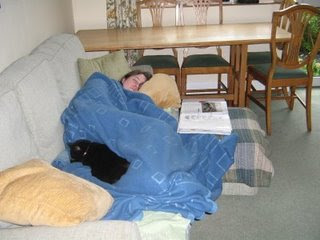
This is a bit of an experiment. Because we meet only once a week – and because you are VERY KEEN (aren’t you?) to do well this year, I thought I’d try a class blog to clarify some of the things we’ve done. The photo above illustrates well how NOT to study...
This is the fifth week of the course, but some people have joined more recently so a bit of revision may be useful for them too. This post is a bit long because it's covering several weeks but I expect future posts to be a bit more concise.
So far, we’ve considered basic grammar. A sentence needs a finite verb (that’s a verb with a subject and a tense) – or it’s not a sentence. If it nevertheless makes sense in context – for example, “In the garden” as a reply to “Where’s the cat?” then it’s a minor sentence.
An excellent site for basic grammar is
http://grammar.ccc.commnet.edu/grammar/It has lots and lots on it. Go to
Word and Sentence Level and click on
verbs and then
subjects. And then read some more!
We’ve also done quite a bit of Close Reading.
Some main points about how to answer Close Reading questions:
To answer Understanding questions – use your own words!
To answer context (Analysis) questions – even if the word “context” isn’t used (it might say “the surrounding sentences” or “the rest of the paragraph”) you must
1.give the meaning of the word or phrase you’re asked to focus on
2. quote from the context
3. show the connection between your meaning and your quotation.
Eg:
The teacher’s unkind words about my essay reminded me of the pejorative comments made by my father when he read it the previous evening.
Question: How does the context help you to understand the meaning of the word “pejorative”? (2 marks)
Answer:
1. “Pejorative” means critical. (1 mark)
2. The writer says “the teacher’s unkind words about my essay”
3. which tells us that the teacher criticised it. (1 mark)
To answer imagery questions – which are usually Evaluation ones:
1. Write about the literal meaning
2. Show the connection with what the writer means here.
Eg: “
The balloon of his self confidence had to be burst”.
Question: Discuss the effectiveness of the writer’s use of imagery. (2 marks)
Answer:
1. It is effective. When a balloon is blown up, it gets much bigger. When it’s burst, it returns to its original size. (1 mark)
2. Similarly, the man had an overinflated idea of his own abilities. He had to be brought down to a more realistic assessment of himself. (1 mark)
We’ve also read chapters 1- 3 of our novel, “A Patchwork Planet” and have noticed several themes emerging already.
One is trust – who trusts Barnaby and who doesn’t?
Another is change – why does Barnaby want to change, and what symbols of change have we already seen?
Another is family relationships – what do we know about these so far?
After next week’s blog post, I expect comments!
 ... Ezra Pound (he survived) or potential painters like...
... Ezra Pound (he survived) or potential painters like... Picasso (so did he). The writer blamed generals like
Picasso (so did he). The writer blamed generals like Earl Haig of Britain and
Earl Haig of Britain and Joffre of France for mismanaging the war. He said that they "exacerbated" it (what does this mean?) and that the press were "compliant" (in what way?)
Joffre of France for mismanaging the war. He said that they "exacerbated" it (what does this mean?) and that the press were "compliant" (in what way?)



 Before starting “A Patchwork Planet” we read Shakespeare’s “A Consolation”, in which the poet thinks of times when he’s been at his lowest ebb and then – “Haply I think on Thee” – perhaps he remembers his beloved – and he’s happy again.
Before starting “A Patchwork Planet” we read Shakespeare’s “A Consolation”, in which the poet thinks of times when he’s been at his lowest ebb and then – “Haply I think on Thee” – perhaps he remembers his beloved – and he’s happy again.
